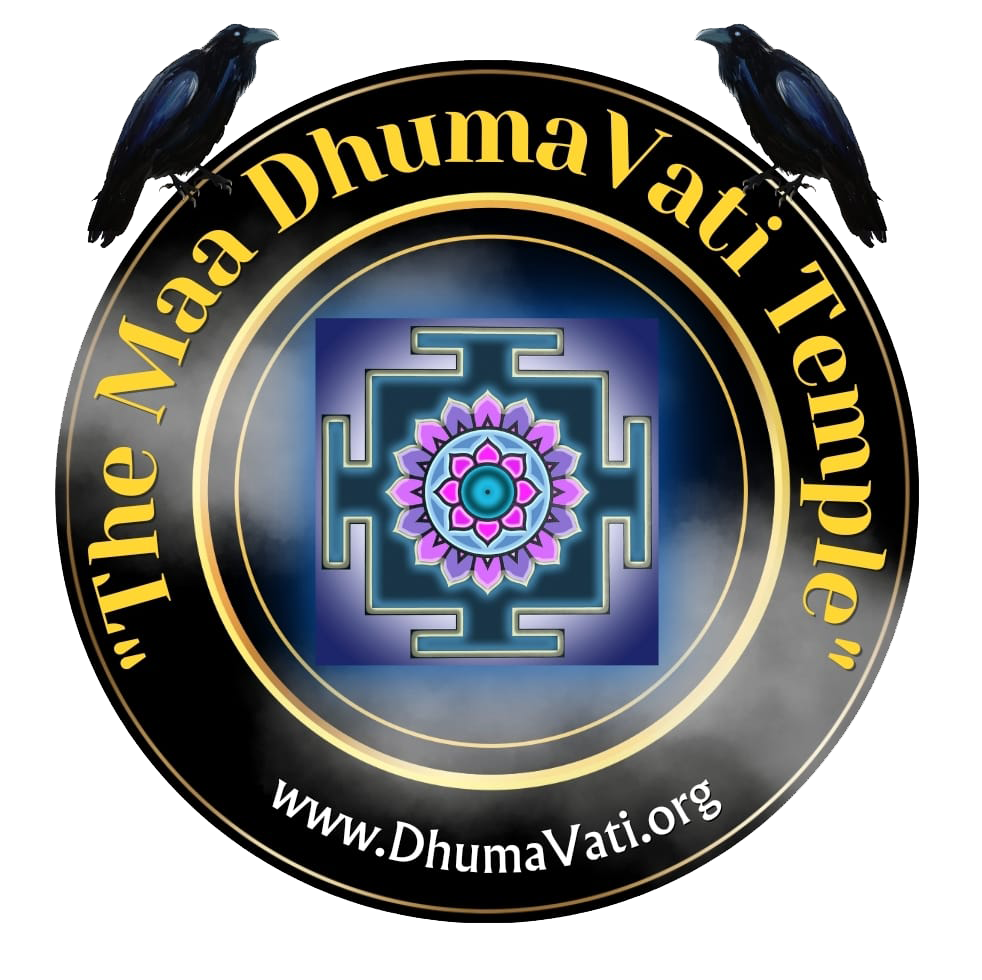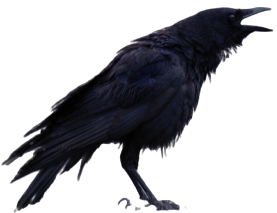
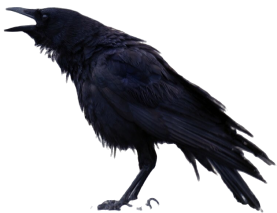
The Divine Mother Maa DhumaVati
"The Divine Mother Maa DhumaVati"
"The Divine Mother
Maa DhumaVati"
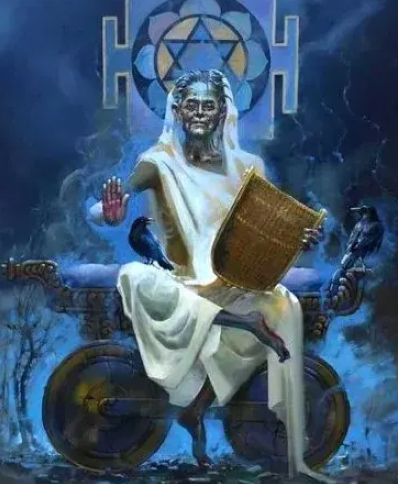
The Divine Mother, Maa Maha Kaali, As Maa DhumaVati Is Revered As The Embodiment Of Divine Blessings in disguise. The Shadowy, And Smoky Aspects Of The Depiction Of Maa DhumaVati, in tantra, Symbolises challenges of your life such as defeat, loss, sorrow, attachment, loneliness etc. The Divine Mother Providing Blessings Secretly And Silently during all these moments of your life. The Divine Mother Is Ever-Present In auspicious moments and in “so-called” inauspicious moments due to lack of wisdom.
Misconceptions
Maa DhumaVati – recognized As Maa MahaVidya – In public literature, especially in western books, The Divine Form Of Maa DhumaVati Is Misunderstood – often wrongly associating with negation, dissolution, and the inauspicious aspects of life.
However, The Appearance As An Old Widowed Woman, Seated On A Chariot Without A Lead – symbolizes the deeper aspects of life which one often faces regularly: poverty, destruction, misfortune, and the inevitable process of death and decay.
Iconography such as Crows, Fire, Smoke, And Desolation – Each Symbol Reinforcing The Connection To death and loss – Hold Deeper Meaning That It Is Only The Divine Mother Maa DhumaVati Who Blesses In such times of need of sincere devotees.
In many interpretations, Maa DhumaVati Symbolizes widowhood, sorrow, and the final stages of life. Concepts that are culturally seen as ominous. This limited public understanding Associates Maa DhumaVati Mainly with the end of things, where hope and renewal seem distant.
While the traditional understanding Of The Depiction Of Maa DhumaVati is limited and even misleading if taken at face value, it has served an important role in transmitting Essential Elements Of The Divine Cosmic Wisdom into the public consciousness.
These Symbols Of decay, destruction, inauspiciousness, misfortune and negation, while seemingly harsh, have functioned as keys or passwords to deeper spiritual truths.
For those attuned, these attributes act as veils, hiding The Divine Cosmic Wisdom Maa DhumaVati Holds Within.
They Conceal Divine Knowledge, Accessible only to The Blessed, those who are mature enough to penetrate through the veil.
Maa DhumaVati Guides Blesses devotees so adversity and challenges can transform into transformative experiences. By Blessings Of Maa DhumaVati, deserving devotees are Enabled to recognize The Blessings of The Divine Mother In both light and darkness of life.
Maa DhumaVati Blesses devotees to learn from challenging aspects of life, with such experiences serving as unique opportunities to learn to overcome worldly desires and to “transcend”.
The Divine Mother Maa DhumaVati Blesses With patience, perseverance, forgiveness, and detachment upon those courageous devotees who embrace these experiences.
History of worship Of Maa DhumaVati
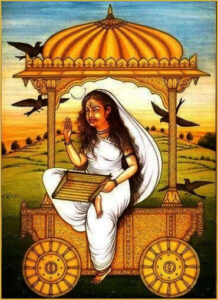
Wisdom On Highest Secrets And Wisdom, Gupt Tantra, is traditionally passed down through direct-transmissions from guru-shishya tradition while maintaining highest secrecy – where written history is is looked down.
The earliest written records of worship Of Maa DhumaVati can be found in tantric texts from the 9th and 10th centuries CE, such as tantrasara and tantraloka.
History of worship Of Maa DhumaVati Is said to go back thousands, tens of thousands or more years, steeped in deep esoteric practices, blending myth, philosophy, and ritualistic worship. The Divine Mother Maa DhumaVati Is Recognised By various communities all across the globe With Various Names And Forms.
These written texts from early centuries provide insights into tantric sadhana (spiritual practice) focused on worship Of The Divine Mother Maa DhumaVati, transcending material desires, illusions, and attachments by seeking Blessings From The Divine Mother Maa DhumaVati.
Many tantric sects worship Maa DhumaVati, often those following what is referred to as the left-hand path (vamachara) rituals. These esoteric practices often involved confronting and integrating the darker aspects within oneself.
However, many communities got simply derailed, focusing too much on ritual – and making it an egoic pursuit of acquisition of siddhis instead of seeking Blessings From The Divine Mother Maa DhumaVati.
Temples For worship Of The Divine Mother
Maa DhumaVati
The Temple for worship Of Maa DhumaVati are usually in secluded places, reflective of esoteric nature of worship, and attracts mainly tantric practitioners and sincere seekers. Such temples and sacred sites hold immense importance for devotees to submit and seek Divine Blessings From The Divine Mother Maa DhumaVati.
Although the worship Of Maa DhumaVati became more common in parts of india since long- it became more common after 1200s, as per some historians who published in some books and articles available.

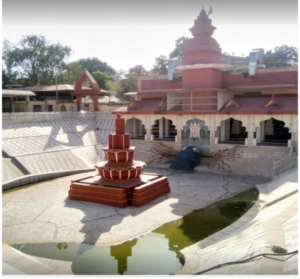
In bengal and northern india, particularly within tantric communities, devotees seek Blessings Of The Divine Mother Maa DhumaVati to overcome obstacles, ego, and to achieve spiritual liberation(moksha). Only recently, in this mature age of kalyug, as realization of the dissolution of the illusion of reality and life comes to the forefront of human consciousness, collective awakening takes shape towards worship Of The Divine Mother Maa DhumaVati.
Two Myths Of Origin
Myth 1
According to first myth, Maa DhumaVati Emerged when Maa Sati Self-Immolated In Her father’s sacrificial ritual.
When Maa Sati Self-Immilated, Maa DhumaVati Arose From Smoke Of Maa Sati’s Burning Body, Embodying Both The Energy Of The Indignant Maa Sati During Self-Immolation And Funeral Smoke.
Myth 2
Second Myth recounts an incident Where Maa Sati, Residing With lord shiva In the himalayas, Grew Extremely Hungry And Asked him for food. When lord shiva refused, Maa Sati Threatened To Consume him, And Indeed Swallowed him. This literal Myth has a a deep esoteric meaning, has Multiple Hidden ‘Wisdom’ associated.
Maa Sati And Lord Shiva are considered As One Whole, And The “Swallowing” Represents Oneness. Here, Maa Sati Getting Hungry Symbolized Desire, As Per A Divine Intent, Of “Maa AdiShakti” To Merge with “shiva”.
Maa DhumaVati – Symbolised The Result And Regression Of “Shiva” And “Maa AdiShakti” Into The Primordial Form – “Maa DhumaVati”.
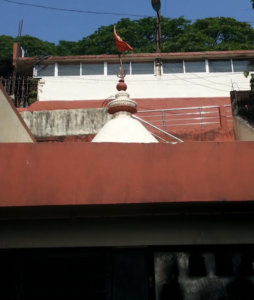
Temples And Pilgrimage Sites
The worship Of Maa DhumaVati has historically been associated with those on the fringes of mainstream practices, particularly within the tantric tradition. From early tantric texts to present-day temples dedicated to the worship
Of The Divine Mother Maa DhumaVati, devotees flock seeking Blessings From The Divine Mother Maa DhumaVati, seeking understanding and embracing life’s darker, inevitable truths for finding The “True Self” beyond the illusions of life’s maya, and attaining liberation.
Varanasi: The “Maa DhumaVati Temple”
Among the temples for the worship Of Maa DhumaVati, notable is The “Maa DhumaVati Temple” in varanasi, india, a significant pilgrimage site and hub of tantric practices associated with the worship Of The Ten Cosmic Wisdom Forms Of The Divine Mother – As Maa Das MahaVidyas. The temple is small and secluded, reflective of esoteric nature of worship, and attracts mainly tantric practitioners and sincere seekers.
In madhya pradesh, india, tantrics perform rituals seeking Blessings From The Divine Mother Maa DhumaVati.
“Maa KamaKhya Temple” Complex In Assam: “A Powerful Shakti Peetha”
In the “Maa KamaKhya Temple Complex”,
The “Maa DhumaVati Temple” is dedicated for the worship Of The Divine Mother Maa DhumaVati, and is a special place of worship, meditation, and transcendence.
Such temples and sacred sites hold immense importance for devotees to submit To The Divine Mother Maa DhumaVati.
The Divine Mother, Maa Maha Kaali, As Maa DhumaVati Is Revered As The Embodiment Of Divine Blessings in disguise. The Shadowy, And Smoky Aspects Of The Depiction Of Maa DhumaVati, in tantra, Symbolises challenges of your life such as defeat, loss, sorrow, attachment, loneliness etc. The Divine Mother Providing Blessings Secretly And Silently during all these moments of your life. The Divine Mother Is Ever-Present In auspicious moments and in “so-called” inauspicious moments due to lack of wisdom.
Misconceptions
Maa DhumaVati – recognized As Maa MahaVidya – In public literature, especially in western books, The Divine Form Of Maa DhumaVati Is Misunderstood – often wrongly associating with negation, dissolution, and the inauspicious aspects of life.
However, The Appearance As An Old Widowed Woman, Seated On A Chariot Without A Lead – symbolizes the deeper aspects of life which one often faces regularly: poverty, destruction, misfortune, and the inevitable process of death and decay.
Iconography such as Crows, Fire, Smoke, And Desolation – Each Symbol Reinforcing The Connection To death and loss – Hold Deeper Meaning That It Is Only The Divine Mother Maa DhumaVati Who Blesses In such times of need of sincere devotees.
In many interpretations, Maa DhumaVati Symbolizes widowhood, sorrow, and the final stages of life. Concepts that are culturally seen as ominous. This limited public understanding Associates Maa DhumaVati Mainly with the end of things, where hope and renewal seem distant.
While the traditional understanding Of The Depiction Of Maa DhumaVati is limited and even misleading if taken at face value, it has served an important role in transmitting Essential Elements Of The Divine Cosmic Wisdom into the public consciousness.
These Symbols Of decay, destruction, inauspiciousness, misfortune and negation, while seemingly harsh, have functioned as keys or passwords to deeper spiritual truths.
For those attuned, these attributes act as veils, hiding The Divine Cosmic Wisdom Maa DhumaVati Holds Within.
They Conceal Divine Knowledge, Accessible only to The Blessed, those who are mature enough to penetrate through the veil.
Maa DhumaVati Guides Blesses devotees so adversity and challenges can transform into transformative experiences. By Blessings Of Maa DhumaVati, deserving devotees are Enabled to recognize The Blessings of The Divine Mother In both light and darkness of life.
Maa DhumaVati Blesses devotees to learn from challenging aspects of life, with such experiences serving as unique opportunities to learn to overcome worldly desires and to “transcend”.
The Divine Mother Maa DhumaVati Blesses With patience, perseverance, forgiveness, and detachment upon those courageous devotees who embrace these experiences.
History of worship Of Maa DhumaVati

Wisdom On Highest Secrets And Wisdom, Gupt Tantra, is traditionally passed down through direct-transmissions from guru-shishya tradition while maintaining highest secrecy – where written history is is looked down.
The earliest written records of worship Of Maa DhumaVati can be found in tantric texts from the 9th and 10th centuries CE, such as tantrasara and tantraloka.
History of worship Of Maa DhumaVati Is said to go back thousands, tens of thousands or more years, steeped in deep esoteric practices, blending myth, philosophy, and ritualistic worship. The Divine Mother Maa DhumaVati Is Recognised By various communities all across the globe With Various Names And Forms.
These written texts from early centuries provide insights into tantric sadhana (spiritual practice) focused on worship Of The Divine Mother Maa DhumaVati, transcending material desires, illusions, and attachments by seeking Blessings From The Divine Mother Maa DhumaVati.
Many tantric sects worship Maa DhumaVati, often those following what is referred to as the left-hand path (vamachara) rituals. These esoteric practices often involved confronting and integrating the darker aspects within oneself.
However, many communities got simply derailed, focusing too much on ritual – and making it an egoic pursuit of acquisition of siddhis instead of seeking Blessings From The Divine Mother Maa DhumaVati.
Temples For worship Of The Divine Mother
Maa DhumaVati
The Temple for worship Of Maa DhumaVati are usually in secluded places, reflective of esoteric nature of worship, and attracts mainly tantric practitioners and sincere seekers. Such temples and sacred sites hold immense importance for devotees to submit and seek Divine Blessings From The Divine Mother Maa DhumaVati.
Although the worship Of Maa DhumaVati became more common in parts of india since long- it became more common after 1200s, as per some historians who published in some books and articles available.


In bengal and northern india, particularly within tantric communities, devotees seek Blessings Of The Divine Mother Maa DhumaVati to overcome obstacles, ego, and to achieve spiritual liberation(moksha). Only recently, in this mature age of kalyug, as realization of the dissolution of the illusion of reality and life comes to the forefront of human consciousness, collective awakening takes shape towards worship Of The Divine Mother Maa DhumaVati.
Two Myths Of Origin
Myth 1
According to first myth, Maa DhumaVati Emerged when Maa Sati Self-Immolated In Her father’s sacrificial ritual.
When Maa Sati Self-Immilated, Maa DhumaVati Arose From Smoke Of Maa Sati’s Burning Body, Embodying Both The Energy Of The Indignant Maa Sati During Self-Immolation And Funeral Smoke.
Myth 2
Second Myth recounts an incident Where Maa Sati, Residing With lord shiva In the himalayas, Grew Extremely Hungry And Asked him for food. When lord shiva refused, Maa Sati Threatened To Consume him, And Indeed Swallowed him. This literal Myth has a a deep esoteric meaning, has Multiple Hidden ‘Wisdom’ associated.
Maa Sati And Lord Shiva are considered As One Whole, And The “Swallowing” Represents Oneness. Here, Maa Sati Getting Hungry Symbolized Desire, As Per A Divine Intent, Of “Maa AdiShakti” To Merge with “shiva”.
Maa DhumaVati – Symbolised The Result And Regression Of “Shiva” And “Maa AdiShakti” Into The Primordial Form – “Maa DhumaVati”.

Temples And Pilgrimage Sites
The worship Of Maa DhumaVati has historically been associated with those on the fringes of mainstream practices, particularly within the tantric tradition. From early tantric texts to present-day temples dedicated to the worship
Of The Divine Mother Maa DhumaVati, devotees flock seeking Blessings From The Divine Mother Maa DhumaVati, seeking understanding and embracing life’s darker, inevitable truths for finding The “True Self” beyond the illusions of life’s maya, and attaining liberation.
Varanasi: The “Maa DhumaVati Temple”
Among the temples for the worship Of Maa DhumaVati, notable is The “Maa DhumaVati Temple” in varanasi, india, a significant pilgrimage site and hub of tantric practices associated with the worship Of The Ten Cosmic Wisdom Forms Of The Divine Mother – As Maa Das MahaVidyas. The temple is small and secluded, reflective of esoteric nature of worship, and attracts mainly tantric practitioners and sincere seekers.
In madhya pradesh, india, tantrics perform rituals seeking Blessings From The Divine Mother Maa DhumaVati.
“Maa KamaKhya Temple” Complex In Assam: “A Powerful Shakti Peetha”
In the “Maa KamaKhya Temple Complex”,
The “Maa DhumaVati Temple” is dedicated for the worship Of The Divine Mother Maa DhumaVati, and is a special place of worship, meditation, and transcendence.
Such temples and sacred sites hold immense importance for devotees to submit To The Divine Mother Maa DhumaVati.
